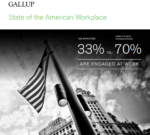 Gallup, Inc. has released its newest State of the American Workplace Report (registration required for access/download). This is the third version of the report. The prior versions were released in 2010 and 2013.
Gallup, Inc. has released its newest State of the American Workplace Report (registration required for access/download). This is the third version of the report. The prior versions were released in 2010 and 2013.
“STATE OF THE AMERICAN WORKPLACE presents an unparalleled look into the modern workforce. The report is based on Gallup’s in-depth research and study and was created to help business leaders optimize their attraction, retention, engagement and performance strategies in a time of extraordinary change. The findings and best practices speak to employees’ evolving wants and needs and give leaders a clear understanding of what it takes to be an exceptional workplace.”1
“Each chapter of State of the American Workplace represents an opportunity for leaders to enhance their human capital strategies.”2 Below are highlights of this 214-page report:
U.S. Workers: Increasingly Confident and Ready to Leave3
“Workers want to feel connected to their job, manager and company. If those ties are not there, they have all the more incentive to quit, leaving their organization to start the costly recruitment, hiring and onboarding dance all over again.”4
“EMPLOYEES ARE LEAVING THEIR JOB FOR NUMEROUS REASONS. THE MOST COMMON EXPLANATIONS EMPLOYEES GIVE WHEN VOLUNTARILY EXITING THEIR JOB ARE:
- career growth opportunities
- pay and benefits
- manager or management
- company culture
- job fit”5
Do Employees Want What Your Workplace Is Selling?6
“Organizations that ignore the need for employer branding could miss their chance to keep talented staff onboard and therefore reduce turnover and maintain productivity.”7
“GALLUP ASKED EMPLOYEES TO INDICATE HOW IMPORTANT CERTAIN ATTRIBUTES ARE WHEN CONSIDERING WHETHER TO TAKE A JOB WITH A DIFFERENT ORGANIZATION. WE FOUND THAT EMPLOYEES PL ACE THE GREATEST IMPORTANCE ON A ROLE AND ORGANIZATION THAT OFFER THEM:
- the ability to do what they do best
- greater work-life balance and better personal well-being
- greater stability and job security
- a significant increase in income
- the opportunity to work for a company with a great brand or reputation”8
The Real Truth About Benefits and Perks9
“Employees don’t expect to be offered every benefit and perk out there, but a handful of programs or amenities are important to them. In some cases, these are attractive enough to make employees consider a job switch. But the most meaningful ones aren’t rock climbing walls and unlimited beverages. The benefits and perks that employees truly care about are those that offer them greater flexibility, autonomy and the ability to lead a better life.”10
“To help leaders identify how well their benefits and perks stand up against those that employees expect or want to receive from their employer, Gallup has identified categories that reflect how important the benefits and perks previously described are to employees in general. The four categories include:
Basics: benefits and perks that most organizations offer and most employees say they would change jobs to get”11
- “retirement plans with an employer match
- health insurance
- paid leave
- paid vacation
- insurance coverage other than health insurance”12
“Important to some: benefits and perks that fewer organizations offer and a segment of employees say they would change jobs to get”13
- “profit-sharing
- flexible work location
- paid time to work independently on a project of the employee’s choosing
- monetary bonuses”14
“Differentiating: benefits and perks that a segment of organizations offer, most employees say they would change jobs to get, and correlate most highly with employee engagement and well-being” 15
- “Flextime”16
“Added value: benefits and perks that some organizations offer and that correlate with employee engagement and well-being, but that employees are less likely to say they would change jobs to get”17
- “reimbursement of fees to attend professional conferences
- sponsorship of local organizations or events that are important to the employee
- flextime during regular office hours to volunteer
- hardware or software reimbursement
- financial planning or coaching
- professional development programs”18
The Competitive Advantage of Engaging Employees19
“Creating a culture of engagement requires more than completing an annual employee survey and then leaving managers on their own, hoping they will learn something from the survey results that will change the way they manage. It requires an organization to take a close look at how critical engagement elements align with its performance development and human capital strategies.” 20
A Shift in Managing Performance21
“Organizations are realizing that more frequent, ongoing conversations may be the missing link in performance management, but there is a huge caveat: Managers have to understand how to have effective performance conversations with employees. Unfortunately, Gallup research suggests that many managers struggle in this area. Our findings indicate that employees largely do not believe that current performance discussions provide clarity or feel meaningful. They do not believe they have a voice in the conversation or a legitimate shot at meeting their goals.”22
“MANY EMPLOYEES ARE NOT MOTIVATED TO PERFORM TO THEIR FULL POTENTIAL. ACCORDING TO GALLUP RESEARCH, THERE ARE THREE MAJOR REASONS FOR THIS APATHY. EMPLOYEES’ L ACK OF MOTIVATION STEMS FROM:
- unclear and misaligned expectations
- ineffective and infrequent feedback
- unfair evaluation practices and misplaced accountability”23
A Closer Look at the 12 Elements of Engagement24
“For organizations, the 12 elements are proven performance management practices that can boost the outcomes of individuals, teams and the entire organization. And they haven’t changed because they continue to improve individual, team and organizational performance.”25
Making Sense of Matrixed Teams26
“Gallup has found that the more matrixed employees are, the more likely they are to strongly agree that being on different teams is beneficial for collaboration, creativity, decision-making, performance, productivity and customer relationships.”27
“But there are tradeoffs for these benefits. The more matrixed that employees become, the less likely they are to say they take time to organize and prioritize their work. More-matrixed employees also say they have less time to work on their assignments.”28
“ACCORDING TO MATRIXED EMPLOYEES, THE THREE MOST IMPORTANT FACTORS IN HELPING THEM PRIORITIZE THEIR WORK ARE:
- clear expectations from my manager
- clear direction from project leaders
- communication between my manager and my project leaders”29
The Changing Place and Space of Work30
“Leaders understand that employees want flexibility and that certain jobs can be done well remotely on either a full- or part-time basis. But leaders also know that most people still work in an office — and benefit from doing so. Surrounded by their team members, employees collaborate and connect with each other and accelerate innovation, creativity and productivity in ways that working remotely sometimes cannot. With a goal to enhance performance, many leaders want to offer flexibility, opportunities to work remotely and open floor plans that meet the demands of the modern workforce.”31
Employee Engagement: A Snapshot32
“EMPLOYEE ENGAGEMENT CAN VARY SUBSTANTIALLY from organization to organization and team to team. Most of the variation in engagement can be attributed to the way performance is managed locally. But at an aggregate level, some differences in engagement can be explained by other factors, including job category, gender, age, geography, company size and education.”33
Final Thought
In the end, “all individuals — leaders, managers and front-line employees — are responsible for upholding their organization’s culture and raising its overall level of engagement and performance.”34
Which of these opportunities to enhance their human capital strategies resonate with you? What are your thoughts on Gallup’s State of the American Workforce 2017 Report?
1 1
2 Ibid., pg 8.
3 Ibid., pg 11.
4 Ibid., pg 18.
5 Ibid., pg 17.
6 Ibid., pg 11.
7 Ibid., pg 23.
8 Ibid., pg 25.
9 Ibid., pg 11.
10 Ibid., pg 41.
11 Ibid., pg 52.
12 Ibid.
13 Ibid.
14 Ibid., pg 53.
15 Ibid., pg 52.
16 Ibid., pg 53.
17 Ibid., pg 52.
18 Ibid., pg 54.
19 Ibid., pg 11.
20 Ibid., pg 71.
21 Ibid., pg 11.
22 Ibid., pg 78.
23 Ibid.
24 Ibid., pg 11.
25 Ibid., pg 97.
26 Ibid., pg 11.
27 Ibid., pg 132.
28 Ibid., pg 134.
29 Ibid., pg 140.
30 Ibid., pg 11.
31 Ibid., pg 150.
32 Ibid., pg 11.
33 Ibid., pg 177.
34 Ibid., pg 195.
Let’s Engage!
I’m Agent in Engagement Simpson…Gregory F Simpson.
Employee engagement is a critical mission. I hope I can count on your help! Subscribe to the RSS Feed to receive the latest intelligence/insights and/or register to make entries in the comments log.
 You can follow me @agtinengagement.
You can follow me @agtinengagement.
Email me at g…@a…t.com.
Connect via LinkedIn at LinkedIn.com/in/GregoryFSimpson.
Learn more about me at gregoryfsimpson.com.
P.S. First contact? Welcome to the Agent In Engagement community. Explore and join fellow employee engagement operatives in targeting a known thief – alias: Disengagement. Together we can bring this thief to justice and make the world a better place for all companies and their employees.
Other recent Agent in Engagement data/reports by Agent Gregory F Simpson:
- Employee Engagement Intelligence Briefing: 2017.02.06 – 2017.02.10
- Veteran Operative Employee Engagement Insights: 02.06 – 2017.02.10
- Employee-Focus is the Result of the Immigration Ban
- Best Employee Engagement-Related Articles of January 2017
- Top 8 Books from the 2016 Agent In Engagement Reading List
- Top 5 Most-Viewed Agent In Engagement Thought Articles of 2016
- New Year’s Resolution: Be a Better Manager in 2017